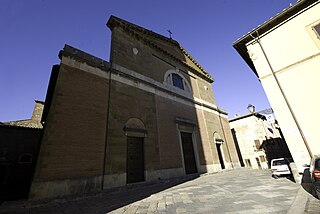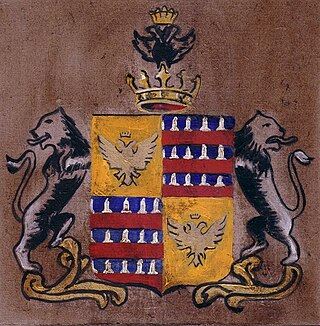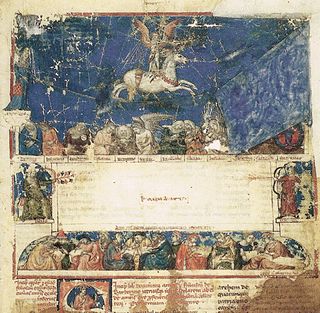
Arezzo is a city and comune in Italy and the capital of the province of the same name located in Tuscany. Arezzo is about 80 kilometres southeast of Florence at an elevation of 296 metres (971 ft) above sea level. As of 2022, the population was about 97,000.

San Gimignano is a small walled medieval hill town in the province of Siena, Tuscany, north-central Italy. Known as the Town of Fine Towers, San Gimignano is famous for its medieval architecture, unique in the preservation of about a dozen of its tower houses, which, with its hilltop setting and encircling walls, form "an unforgettable skyline". Within the walls, the well-preserved buildings include notable examples of both Romanesque and Gothic architecture, with outstanding examples of secular buildings as well as churches. The Palazzo Comunale, the Collegiate Church and Church of Sant' Agostino contain frescos, including cycles dating from the 14th and 15th centuries. The "Historic Centre of San Gimignano" is a UNESCO World Heritage Site. The town also is known for saffron, the Golden Ham, pecorino cheese and its white wine, Vernaccia di San Gimignano, produced from the ancient variety of Vernaccia grape which is grown on the sandstone hillsides of the area.

Bobbio is a small town and comune in the province of Piacenza in Emilia-Romagna, northern Italy. It is located in the Trebbia River valley southwest of the town Piacenza. There is also an abbey and a diocese of the same name. Bobbio is the administrative center of the Unione Montana Valli Trebbia e Luretta. It is a member of the I Borghi più belli d'Italia association.

Colle di Val d'Elsa or Colle Val d'Elsa is a town and comune in the province of Siena, Tuscany.

Calenzano is a comune (municipality) in the Metropolitan City of Florence in the Italian region Tuscany, located about 11 kilometres (7 mi) northwest of Florence. As of 31 December 2004, it had a population of 15,557 and an area of 76.9 square kilometres (29.7 sq mi).

Castelfiorentino is a city and comune (municipality) in the Metropolitan City of Florence, Tuscany, central-northern Italy, halfway between Florence, Pisa (45 km) and Siena (55 km). The population is approximately 20,000 inhabitants. It is part of Valdelsa. Castelfiorentino borders the following municipalities: Certaldo, Empoli, Gambassi Terme, Montaione, Montespertoli and San Miniato.

Montespertoli is a comune (municipality) in the Metropolitan City of Florence in the Italian region Tuscany, located about 20 kilometres (12 mi) southwest of Florence.

Tavarnelle Val di Pesa is a former comune (municipality) and since 2019 a frazione of Barberino Tavarnelle in the Metropolitan City of Florence in the Italian region Tuscany. It is located about 25 kilometres south of Florence.

Castellina in Chianti is a comune (municipality) of c. 2,800 inhabitants in the province of Siena, in the Italian region Tuscany, located about 35 kilometres (22 mi) south of Florence and about 15 kilometres (9 mi) northwest of Siena. It is part of the Chianti Hills, between the valleys of the Arbia, Pesa and Elsa rivers.
San Bartolomeo may refer to:

Semifonte was a fortified city in Tuscany, Italy, built during the late 12th century and destroyed after a siege by Florence in 1202. Its remains are within the modern comune of Barberino Val d'Elsa.
Andrea Mangiabotti, called Andrea da Barberino, was an Italian writer and cantastorie ("storyteller") of the Quattrocento Renaissance. He was born in Barberino Val d'Elsa, near Florence, and lived in Florence. He is principally known for his prose romance epic Il Guerrin Meschino, his I Reali di Francia, a prose compilation of the Matter of France epic material concerning Charlemagne and Roland (Orlandino) from various legends and chansons de geste, and for his Aspramonte, a reworking of the chanson de geste Aspremont, which also features the hero Ruggiero. Many of his writings probably derive from Franco-Italian works, such as the Geste Francor, that includes versions of the stories of Reali di Francia and dates to the first half of the fourteenth century. His works, which circulated at first in manuscript, were extremely successful and popular, and were a key source of material for later Italian romance writers, such as Luigi Pulci (Morgante), Matteo Maria Boiardo and Ludovico Ariosto.

The history of Chianti dates back to at least the 13th century with the earliest incarnations of Chianti as a white wine. Today this Tuscan wine is one of Italy's most well known and recognizable wines. In the Middle Ages, the villages of Gaiole, Castellina and Radda located near Florence formed as a Lega del Chianti creating an area that would become the spiritual and historical "heart" of the Chianti region and today is located within the Chianti Classico Denominazione di Origine Controllata e Garantita (DOCG). As the wines of Chianti grew in popularity other villages in Tuscany wanted their lands to be called Chianti. The boundaries of the region have seen many expansions and sub-divisions over the centuries. The variable terroir of these different macroclimates contributed to diverging range of quality on the market and by the late 20th century consumer perception of Chianti was often associated with basic mass-market Chianti sold in a squat bottle enclosed in a straw basket, called fiasco.

Colle di Val d'Elsa Cathedral is a Roman Catholic cathedral in Colle di Val d'Elsa, Tuscany, Italy. Anciently a pieve of the Holy Saviour, it is now dedicated to Saints Albert and Martial. Formerly the episcopal seat of the Diocese of Colle di Val d'Elsa from its creation in 1592, it is now a co-cathedral of the Archdiocese of Siena-Colle di Val d'Elsa-Montalcino.

Montalcino Cathedral is a Roman Catholic cathedral in Montalcino in the province of Siena, Italy. Formerly the seat of the bishops of Montalcino, since 1986 it has been a co-cathedral in the Archdiocese of Siena-Colle di Val d'Elsa-Montalcino. It is dedicated to the Holy Saviour.

The Gherardini of Montagliari was one of the most prominent historical Italian noble families from Tuscany, Italy. Through the Amideis, the family was of Roman descent. Between the 9th and 14th centuries, they played an important role in Tuscany. Its influence was also felt in the Veneto and Emilia regions between the 16th and 18th centuries, and during the Italian Risorgimento as well as in today's Italian politics and economy. The family’s restless and fighting nature has aroused the curiosity of many historians of the Middle Ages. Originating from feudal tradition, it was one of the founding families of the Republic of Florence.

Villa di Spoiano is a renaissance villa located on a hillock between Tavarnelle Val di Pesa and Barberino Val d'Elsa. It has been cited for the first time in 1689 by San Jacopo a Magliano.

Valdelsa or Val d'Elsa is the valley of the river Elsa, in Tuscany, central Italy. The valley is divided into two traditional regions: Alta Valdelsa, in the province of Siena, Poggibonsi being the largest town in the area; and Bassa Valdelsa, in the Metropolitan City of Florence, Empoli being the largest town. Other centers in the valley include Castelfiorentino, Certaldo, Colle di Val d'Elsa and San Miniato.
The Museum of Religious Art' is an art gallery and museum in Certaldo, opened in 2001 and one of the town's three museums.

Francesco di Neri di Ranuccio, known better as Francesco da Barberino (1264–1348), was a Tuscan notary, doctor of law and author.



















